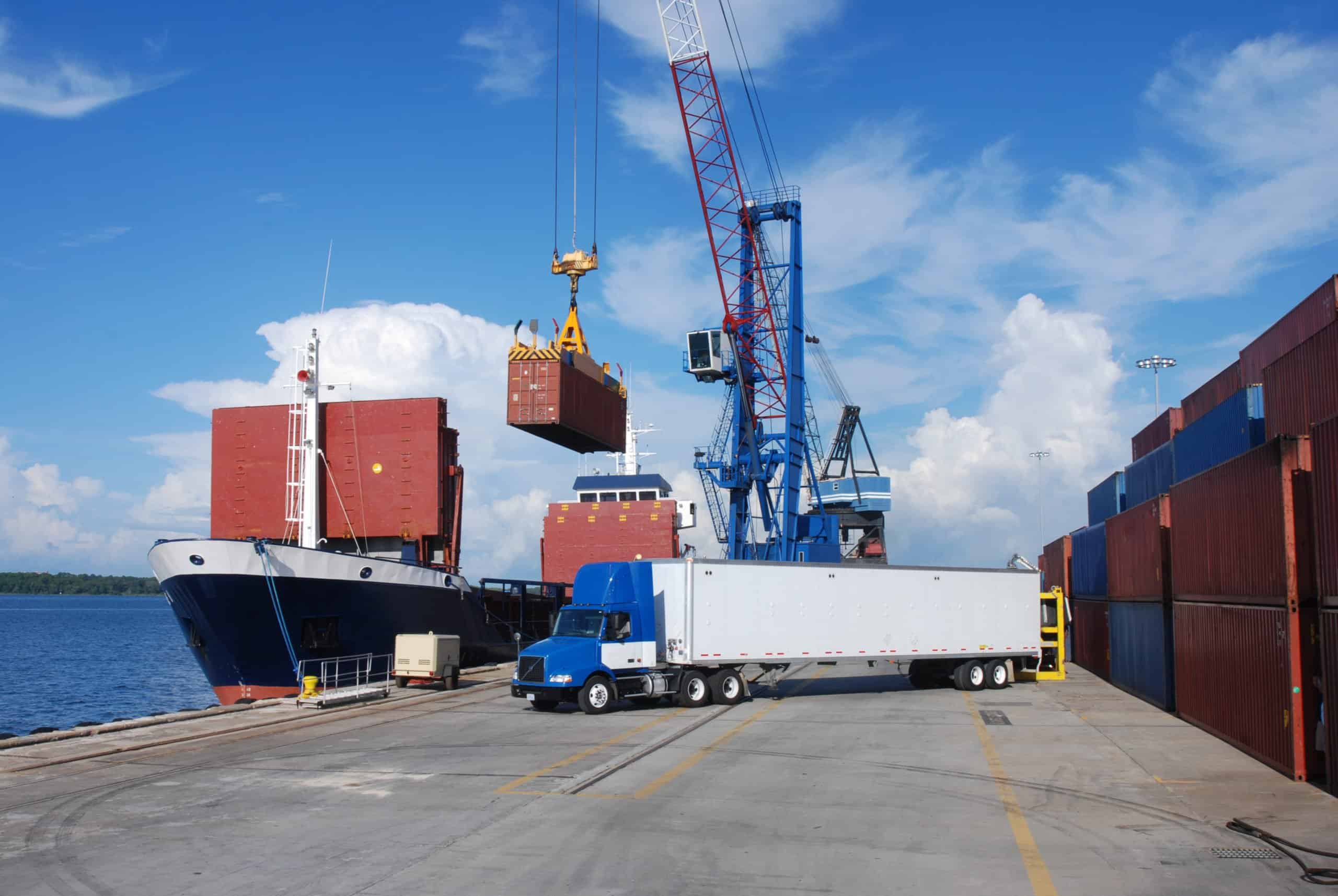Issue 4: As Retail Demands Sort, Import Levels Plummet

Hello, again, and welcome to the Legacy Monthly shipment, where we explore and share our unique perspective on the latest supply chain industry topics, trends, and news.
As the world continues to adapt to the “new normal” of COVID-19, so, too, has the global supply chain. To that end, there are a number of stories this month that have had everyone here at Legacy buzzing, and we can’t wait to share them with you. Let’s dive right in.
Today’s Shipment:
- NRF forecasts lowest import levels since 2014 — but not all hope is lost.
- FAA decision increases available air freight capacity in market — but does it come too late?
- Southeast U.S. ports see increased shipping volumes as companies diversify sourcing.
- Omnichannel supply chains drive warehouse demand, lead to low vacancy rates for the foreseeable future.
- Legacy unveils new international transportation dashboard in partnership with Logixboard.
FORECAST
Retailers Play Things Close to the Vest in Light of Unpredictable Demand
According to a forecast recently published by the National Retail Federation, import levels at U.S. ports are anticipated to remain lower than 2019 heading into the fall. The forecast predicts that, despite it being the busiest month of peak season, only 1.7 million TEUs will be handled in October, which would make fall 2020 the lowest peak since 2014. Though the effects of the recession have abated slightly due to businesses reopening, renewed restrictions resulting from an uptick in COVID-19 cases in certain states have led retailers to be more conservative with the amount of merchandise they import.
But don’t despair — though the findings of the forecast are true, at least to some degree, Legacy has seen mixed results with our own retail clients. In some cases, some retailers have seen strong sales throughout the pandemic; even those that experienced a reduction in sales are starting to rebound as the demand for retail goods increases. Given this higher demand and the continued strong ocean freight market, we urge our clients to continue to forecast demand, plan ahead and book early.
NEWS
FAA Finally Grants Approval for Removal of Passenger Seats for Cargo
In the April 2020 issue of this newsletter, we ran a story about how substituting cargo for passengers was well on its way to becoming a mainstream line of business for many major commercial airlines. An update: The Federal Aviation Administration has finally granted U.S. airlines permission to remove passenger seats and instead transport cargo on the cabin floor. The decision comes two months after a U.S.-based airline trade group petitioned for exemption from normal aircraft operating rules, and a full three after some international carriers began adopting this practice.
Though this ruling might have been welcome news back in April, the demand for repurposed passenger jets to increase global cargo capacity has waned in the months since. That said, it appears as though COVID-19 is unlikely to go away any time soon, meaning there is still potential for increased demand for express air deliveries in the very near future. This has left many U.S. airlines wondering whether the cost to convert aircraft is worth the potential gain.
The fact of the matter is that there’s an excess of both passenger and cargo aircraft. Whether there’s any merit to transitioning passenger aircraft into cargo aircraft all comes down to forecasting demand. From where Legacy stands, we have reason to believe that — at least, in the medium term — the demand for cargo planes will increase faster than that for passenger planes. Air cargo rates have stabilized across many trade lanes, so adding capacity will enable shippers to better manage and, in some cases, reduce costs. For shippers with expedited needs, the new capacity as a result of the FAA’s decision could make air freight more appealing. If you’re uncertain whether air freight is a smart choice for your business, Legacy can help you explore your options.
OBSERVATION
China Plus One Model Increases Import Volume in Southeast U.S. Warehousing Markets
The disruption caused by COVID-19 has led many companies to reexamine their supply chains and adopt a China Plus One business model — that is, to diversify their operations by sourcing goods from Europe and other parts of Asia in addition to China. Given that many of these “Plus One” countries are able to access the U.S. more efficiently via the Suez Canal, ports in the American Southeast and along the Gulf Coast have seen a significant increase in import volume. Although China will likely remain the dominant supplier in the global supply chain, this increase in volume is indicative of a larger shift in global trade patterns as a direct result of COVID.
It’s a story that the Legacy team has been following closely. In recent years, we’ve seen an increased demand for cargo into the Southeast. Though the West Coast remains the largest trade lane in the U.S., we have reason to believe that the recent uptick in volume is consistent with companies looking to mitigate the risks of sole sourcing from China. In addition to Europe and other Asian countries, we’re seeing a trade triangle start to develop between Asia, Mexico, and the U.S., with goods sourced from Asia, assembled in Mexico, and shipped to the U.S.
From our perspective, shippers are right to diversify their supplier base. Although global supply chains are here to stay, they aren’t without risk, be it geopolitical situations, natural disasters, labor issues, and so on. Diversification can help mitigate these risks and should be a key component of any client’s logistics contingency plan.
REPORT
Official 2020 State of the Logistics Union Reports Historically Low Vacancy Rates
Though the demand for warehouse space has been strong for the past few years, based on the 2020 State of Logistics Report released by the Council of Supply Chain Management Professionals, vacancy rates have reached historic lows. According to the report, if the eCommerce industry continues to grow at its projected rate, it will be almost impossible for warehouses and distribution centers to accommodate the ensuing increase in demand. In anticipation of this, shippers have already started to seek alternative paths to eFulfillment, including dark stores, smaller warehouses in urban areas and automated goods-to-person technology.
Despite significant new construction of distribution space, there are several driving forces behind the continued downward trend of space availability. As businesses continue to evolve their omnichannel supply chains, there are new pressures to deliver faster and at lower costs than ever before. Gone are the days of one or two large scale distribution centers — today’s omnichannel reality calls for a more decentralized multi-site model that can also incorporate fulfillment from store and drop shipping direct from suppliers and distributors. Other contributing factors include forced expansion as a result of uncertainty around trade tariffs and contraction of distribution center space usage; the COVID-19 pandemic has also contributed to reduced consumption in Q1 and Q2, leading to inventory buildup. While some of this excess inventory should loosen up as the economy rebounds, the continued high demand for space to support the growing eCommerce sector will likely keep warehouse vacancy rates low for the foreseeable future.
To offset this uncertainty, companies need partners that provide flexibility, scalability and strategic support. Partnering with a third-party logistics provider enables businesses to adapt to changing market conditions, leverage existing distribution infrastructure and technologies to support growth, and access a consultative voice in order to create a synchronized supply chain that serves all sales channels.
UPDATE
See What Legacy’s Been Up To
We’re excited to announce our new international transportation dashboard. Developed in partnership with Logixboard, a freight forwarding solution provider, this cloud-based software platform includes a slew of features designed to give our clients greater control over and visibility into their business, including a shipments command center and robust shipment analytics.
We’re also in the process of adding functionality that will enable Legacy to focus on solving customer problems and identifying new opportunities for improvement. We look forward to hearing our clients’ feedback on this new dashboard; we intend to continue to evolve the current feature set as time goes on, and to incorporate domestic transportation activity at a future date.
We’re curious: How has your business adapted to the “new normal” of COVID-19? Shoot us an email and let us know — we’d love to hear from you. As always, for more supply chain-related news and insights, you can head on over to our blog or talk to one of our specialists today.
Get Insights. Stay Ahead.
Get the latest news and insights via email on warehouse improvement, transportation optimization, labor strikes and international shipping rate changes.Popular Posts
Search Posts
-
2024 Q1 Freight Landscape: Trends, Challenges, and Predictions
As the first quarter of 2024 comes to an end, here are some observations over the past few months as well as predictions about the trucking...
+ Read more -
Baltimore Bridge Impact Assessment – Update
Following the recent Baltimore Bridge collapse and subsequent port closures, we want to keep our customers informed about the situation and...
+ Read more -
Global Momentum Builds for Charge on Global Shipping Sector’s CO2 Emissions
A growing coalition of 47 countries, including key players like the European Union, Canada, Japan, and various Pacific Island nations, is...
+ Read more










